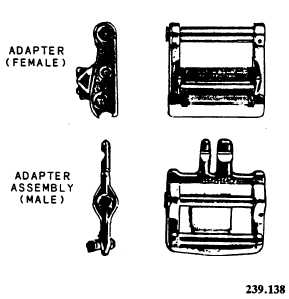the harness snap and is used as a means to quickly
attach the Navy chest-type parachute to the two
D-rings on the Navy chest-type harness.
CONNECTOR LINKS
Connector links are fittings designed to join
the parachute to the harness. The suspension lines
are attached to one side and the harness to the
other connector links.
KOCH RELEASE ADAPTERS
Integrated torso suit harnesses are equipped
with four Koch release adapters, which attach to
the fittings on the lap belts and risers of the
integrated parachute assembly. Release fitting
adapters are manufactured in two parts-male
and female.
The male portion of the adapter is attached
to the torso suit harness, while the female portion
is attached to the riser assembly of the parachute.
Figure 1-11 shows the Koch parachute release
adapters.
NOTE: Aircrew Systems Change 446
incorporates the “parachute harness
sensing release unit,” commonly referred
to as SEAWARS. SEAWARS is designed
to automatically release the parachute
risers upon immersion in seawater.
TRANSPORTING PARACHUTES
When issuing parachutes you may need to
give some instructions to the aircrewmen on
proper ways to carry and handle them. The
most effective way to explain the proper handling
of packed parachutes is to list a series of DO’s
and DON’T’s.
1. DO NOT pick up a parachute by its
risers or ripcord. Lift web tackings break
relatively easily, and when they do, the sus-
pension lines are almost certain to become
disarranged.
2. DO NOT allow a parachute to come in
contact with light fixtures or heat sources.
Heat tends to decompose the fabric.
3. DO take EVERY precaution to pre-
vent soiling or contaminating parachute as-
semblies.
4. DO NOT stack parachute assemblies on
top of each other or on the floor, unless they are
in suitable shipping containers.
5. DO NOT leave a parachute where
heavy objects can be dropped or placed on
it. Permitting a parachute to be carried in
a cargo net along with squadron cruise boxes
or similar gear is an example of poor handling
techniques.
6. DO use utmost CAUTION when handling
parachute assemblies with installed cartridge-
activated devices.
7. DO NOT tack or tie a container with the
parachute in the packed condition.
8. DO clean thoroughly vehicles used
to transport parachute assemblies. DO check
for contamination and provide with suitable
covers during inclement weather.
SHIPPING CONTAINERS
Figure 1-11.—Koch release adapters.
Parachutes are shipped and/or stored in
sealed shipping containers of either card-
board or metal construction and of suitable
size. The containers are designed for reuse,
and they must be opened and closed with
care.
1-13

